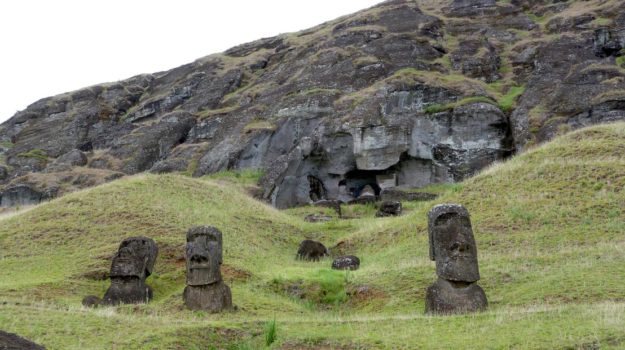System Rapa Nui – Superstudio 2018
Paolo Tombesi, EPFL Professor in architecture and Head of the Laboratory of Construction and Architecture (FAR) at the Smart Living Lab, tells us about the “System Rapa Nui – Superstudio 2018”, the first edition of an ambitious three-year course aimed to address the environmental challenges of Easter Island.
Can you describe the project?
Architecture is conventionally associated with specific types of design activity, realization processes and concrete, inhabitable artifacts. As such, it is considered the province of a specific profession, separate from engineering, urban planning, material science, environmental design, regional development. What would happen if we interpreted the word architect differently, almost as a verb in fact – to architect? Would it change the conceptual dimension of the work and the position of those who practice it?
It is in part to answer these questions that, from 2018, the Architecture Section of the School of Architecture, Civil and Environmental Engineering (ENAC) has started directing the focus of Superstudio, its final-year research studio of its entire cohort of over 100 students, towards the investigation of the environmental challenges that characterize Rapa Nui, the remote legendary island in the middle of the Pacific Ocean, home to the Moai sculptures and also known as Easter Island.
For its subsistence, Easter Island relies on energy supplies from the South American continent, 2,000 nautical miles away, whilst sending packaged waste back to it by plane and by boat. Such sombering facts cast just enough light on the pressures that isolation, small size and limited sets of resources place on certain territories’ ability to sustain their own livelihood. In spite of its global fame and inscription in the list of World Heritage sites, Rapa Nui exists on a path of general resource dependency that ties it to the mainland nation it belongs administratively, Chile, and which conditions not only development opportunities but also built environment characteristics. Within an economic landscape however defined by remoteness-related high cost of living and scarcity, human settlements present numerous challenges – from land use to soil erosion and contamination, production and management of waste to infrastructural upkeeping, construction materials selection to typological choices. What sort of analyses should thus inform the design of buildings on the island? What sort of deliberative actions define ‘architecture’ in this context? How should buildings be approached and examined?
In collaboration with Easter Island’s local government and Chilean universities, Superstudio is set to articulate a response in three years. Year 1 (2018) – ‘System Rapa Nui’ – focused on the development of regional analytical methods capable to consider and integrate the issues affecting not only territorial sustenance but also community thriving at macro level. Year 2 (2019) – ‘Space Rapa Nui’ – will focus on the technological choices implied within such visions, and the spatial organization and inhabitation patterns they naturally favour. Year 3 (2020) – ‘Volume Rapa Nui’ – will translate technological decisions into building strategies, programs and prototypical structures.
Why is Easter Island a good context to work on for students in architecture?
Easter Island is an ideal place to study in the context of modern environmental science, planning and technology. On the one hand, it represents a living community subject to all the social and economic pressures or tensions of a developing, multi-ethnic, connected, contemporary society. On the other hand, it has to deal with this condition while existing in a minuscule pocket of land lost in the middle of an ocean, which also happens to be of world heritage status and thus in need of preservation. This places enormous strain on the environmental balancing of economic growth and industrial progress, as well as on the safeguarding of the identity associated with the myth of the island and its habitat.
Through remoteness and scarcity, Easter Island brings emphatically together sustainability, culture, energy, material science, engineering, health, farming, housing, waste, pollution, recycling, traditions, craft, and much more.
Significantly, the territory’s defining spatial quality – isolation – facilitates the examination of the dynamic relationships between the elements of this conceptually complex eco-system. Students have the opportunity to understand and follow ultimately physical relations that it would be impossible even to detect in a larger and less self-contained geographic unit.
In light of all this, Easter Island brings the meaning of architecture into question: What can happen to it in a world characterised by absolute lack of design autonomy – where everything, that is, is apparently a function of something else? What would the role of architects and the tools of the discipline become then? Work on Superstudio suggests the critical value of shifting the focus of the analysis provisionally away from objects and onto the determination/facilitation of privileged relationships based on the interpretation of data sets. At the end of the day, Easter Island is more than a beautifully exotic place; it is a very useful operational paradigm for the rest of the world.
What did the students do when they travelled over there in January 2019?
In the second part of Superstudio, half-way through the winter semester, students worked in groups to outline the possible terms of a regional development policy for the island, ostensibly aimed at connecting, socially as well as physically, the issues affecting the full sustenance of the territory at a macro scale.
The idea, however, was not to leave this work at a speculative level. Since Superstudio is a multi-year / multi-dimensional project carried out in collaboration with partner communities in Chile and Easter Island, the results of the exercise had to be shared and discussed with the actual actors in the process. To this end, we selected a group of 18 students who travelled to Easter Island for a week, so as to lay out, in a well-attended public forum, the visions articulated in Lausanne and receive feedback from the local constituencies. The result of the ensuing discussions will work as the basis for the work to be carried out in Superstudio 2019.
The students took the visit as an opportunity to meet with island residents, activists and operators, experience the place, understand the context, and thus verify the validity of their initial assumptions. In the process, they came face to face with the Moai, got sunburnt, learned to surf, planted pineapples, visited ritual caves, rode horses, fished the ancient way, examined pre-industrial prefabrication, lived on ceviche, made good friends, and, last but not least, became successful ambassadors of EPFL.
What makes ENAC School competences and education relevant for the issues encountered in Easter Island?
From my answers to your previous questions, it would sound like it is more the other way around – how relevant the issues encountered on Easter Island are for our students’ awareness and preparation to act as truly technical citizens of our world. There is no doubt that Easter Island makes for a great intellectual gym, where the need for a comprehensive approach to environmental design and regional development gets displayed with shining clarity. In the absence of a dedicated curriculum, our students had to follow a very steep learning curve. At times this produced elation, at other times frustration.
Yet, it is also true that the approach we elected to follow presupposes the multidimensional engineering base already at the core of ENAC and, more in general, of EPFL. This is important, because there are not many institutions around the world in a position to harness from within the broad arsenal of knowledge required to tackle the integrated challenges present in and presented by Easter Island. In other words, it is the very problem we tried to address – the ability of small regions to provide for their future by envisioning and enacting circular economies appropriate to their locale, which defines ‘structurally’, and irrespective of the school's current training paths, the global relevance of institutions such as ours when it comes to tackling instances of underdevelopment and environmental imbalance. If we accept this as both a privilege and a responsibility, we simply need to work to make sure that the preparation and the mindset of our students is par for our natural course. I cannot think of a better reason for Superstudio.
This article was published on 13 March 2019 in a short version in the 24th edition of EPFL Magazine.

